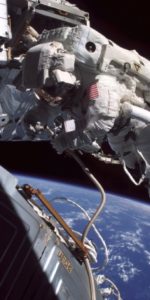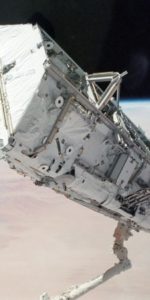
Denied a second spaceflight by then-President John F. Kennedy, reportedly on account of his value to the nation as America’s first man to orbit the Earth, Astronaut John Glenn will launch on his third mission on Tuesday, 18 April, aboard a modern incarnation of his old Atlas rocket. His space-time tally—which currently consists of a five-hour Mercury mission in February 1962 and a nine-day Space Shuttle flight in the fall of 1998—will be extended on a three-month-plus voyage to the International Space Station (ISS).
At least, that is, in spirit.
Last month, Orbital ATK revealed that its next ISS-bound Cygnus cargo mission to the ISS will be named in his honor. “Glenn, the first American to orbit Earth, was a lifelong pioneer of human spaceflight,” it recently announced. “Glenn paved the way for America’s space program, from Moon missions to the Space Shuttle and the International Space Station. His commitment to America’s human spaceflight program and his distinguished military and political career make him an ideal honoree for the OA-7 mission.”
This naming convention is entirely in keeping with the Dulles, Va.-headquartered company’s growing tradition of memorializing deceased U.S. astronauts. Between September 2013 and October 2016, seven Cygnus vehicles have borne the names of veteran shuttle flyers Rick Husband, C. Gordon Fullerton, Janice Voss, G. David Low and Alan Poindexter, as well as Glenn’s Project Mercury comrade Donald “Deke” Slayton. Of this list, only Husband and Poindexter actually boarded the ISS in person, whilst Slayton gained the unexpected accolade of having not one, but two Cygnus ships named for him. His first Cygnus exploded in a fireball, seconds after liftoff in October 2014, but he finally made it to the space station, in spirit, on OA-4 a year later.
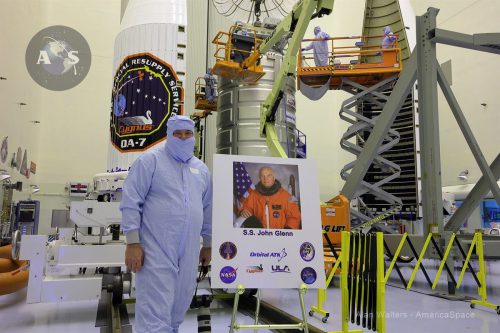
Tuesday’s OA-7 mission is part of Orbital ATK’s Commercial Resupply Services (CRS) commitment to NASA, signed back in December 2008 by Orbital Sciences Corp. Under the $1.9 billion initial contract, the company was required to fly at least eight Cygnus spacecraft and deliver 44,000 pounds (20,000 kg) of equipment and supplies to successive ISS crews. A “demonstration” mission in September 2013 was followed by two dedicated flights in January and July 2014, followed by three further successes between December 2015 and October 2016. It was always intended that Orbital’s home-grown Antares booster would launch the Cygnuses, but the October 2014 failure led directly to a decision to bring ULA on-board, staging at least two missions on its highly reliable Atlas V.
Although Antares successfully returned to flight last fall, its two-year hiatus in operations caused concern for NASA. The agency’s need for “enhanced schedule assurance” from its CRS partner led Orbital ATK to contract in November 2016 for ULA to fly the OA-7 Cygnus aboard its Atlas V. As a result, this mission will be the first to be executed under ULA’s RapidLaunch architecture, unveiled last year to provide an accelerated hardware schedule for customers and enable payloads to be launched as quickly as three months after initial order. Following OA-7, successive Cygnus missions—beginning with OA-8 in the late summer—are expected to launch again atop Antares.
As outlined previously by AmericaSpace, OA-7 will transport approximately 7,452 pounds (3,380 kg) of payload to the ISS. This includes an advanced plant habitat for emplacement inside Japan’s Kibo lab, as well as investigations to support research in chemotherapy drugs, magnetic cell culturing and bioprinting and crystal growth, together with flight-testing new thermal-protection technologies for re-entry and a flotilla of QB50 CubeSats for in-situ observations of Earth’s lower thermosphere. Additionally, OA-7 will carry vehicle hardware, crew supplies, computer resources and Extravehicular Activity (EVA) equipment. This mission marks the fourth voyage of Orbital ATK’s “Enhanced Cygnus”, which benefits from a longer Pressurized Cargo Module (PCM) than the original “Standard Cygnus” and can deliver a 60-percent larger haul of supplies to the ISS.
The PCM is based in design upon Italy’s Multi-Purpose Logistics Module (MPLM), launched aboard the shuttle on 12 occasions between March 2001 and July 2011 and one of which—the Leonardo Permanent Multipurpose Module (PMM)—has now been attached to the ISS for more than six years. Combined with a Service Module (SM), the Enhanced Cygnus stands 15.9 feet (4.86 meters) tall, about 3.9 feet (1.2 meters) higher than the Standard Cygnus, and although their diameters are the same at 10.1 feet (3.1 meters), the Enhanced variant is 4,000 pounds (1,800 kg) more massive and can handle a larger payload volume of around 950 cubic feet (27 cubic meters). The Enhanced Cygnus is fitted with lightweight UltraFlex solar arrays, whose fan-like shape makes the overall “look” of the spacecraft distinct to the wing-like appendages of the Standard Cygnus.
In readiness for OA-7, the PCM was delivered via flatbed truck to the Space Station Processing Facility (SSPF) at the Kennedy Space Center (KSC) in Florida, in the second week of January, followed by the SM at month’s end. The pair were mated in mid-February and on 2 March the complete spacecraft arrived in the Payload Hazardous Servicing Facility (PHSF) for fueling. At length, Cygnus was encapsulated within the 45.3-foot-long (13.8-meter) Extra-Extended Payload Fairing (XEPF), ahead of installation atop the launch vehicle in the Vertical Integration Facility (VIF) at Space Launch Complex (SLC)-41 at Cape Canaveral Air Force Station, Fla.
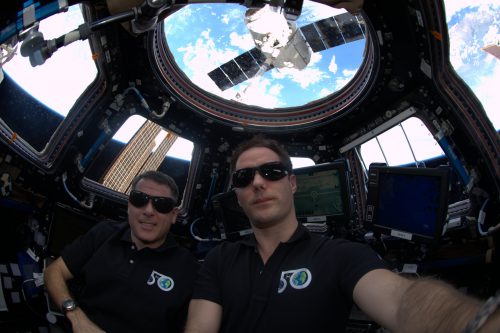
Concurrently, preparations were well underway to prepare ULA’s workhorse Atlas V booster for its third mission to the ISS. Early in February, the 106.5-foot-long (32.5-meter) Common Core Booster (CCB) of the Atlas V arrived at the Cape. Powered by a dual-nozzle RD-180 engine, built in Russia, the CCB produces a thrust of 860,000 pounds (390,000 kg) at T-0. Shortly thereafter, it was mated to the 41.5-foot-long (12.6-meter) Centaur upper stage, and the Atlas V was later topped-off by the addition of the XEPF and its OA-7 Cygnus payload. When complete, the vehicle stood an impressive 194 feet (59 meters).
Tuesday’s Atlas V will fly in its “barebones” 401 configuration, equipped with a 13-foot-diameter (4-meter) payload fairing, no strap-on rocket boosters and the single-engine Centaur upper stage. This will be the 36th flight of the 401, which has been employed by ULA since March 2007, and previously by Lockheed Martin, since the Atlas V’s maiden voyage in August 2002. Last month, the Atlas V fleet completed its milestone 70th launch, successfully delivering NROL-79 into orbit on behalf of the National Reconnaissance Office (NRO). With OA-7 representing the 71st flight, Tuesday’s launch means that more than half of all Atlas V missions have been conducted by the 401.
It carries the potential to deliver up to 21,600 pounds (9,800 kg) into low-Earth orbit, making it ideally suited for Cygnus. In fact, the 16,500-pound (7,500 kg) OA-4 in December 2015 marked the heaviest-ever payload to be launched by an Atlas. OA-7 will fall a little short of this record, with a total weight of 15,928 pounds (7,225 kg).
Rollout of the Atlas V from the VIF to the SLC-41 pad surface—a distance of about a quarter-mile (400 meters) and requiring around 35 minutes—is slated to occur tomorrow (Monday). When the booster is “hard-down” on the pad, it will be carefully centered and propellant umbilicals and data connections will be established. The track mobiles from the Mobile Launch Platform (MLP) will be removed and ULA engineers will set to work preparing for formal countdown operations. This process includes the initiation of flight control systems, the bringing online of ground command, control and communications instrumentation and the verification of interfaces between the Atlas V and the Launch Control Center (LCC).
Launch was originally targeted for 19 March, but was postponed until no sooner than the 21st. “Add’l time allows ULA to replace, retest a first-stage hydraulic component,” ULA tweeted last week. “#Atlas V and #Cygnus remain secure in their processing facilities.” This date subsequently slipped to the 24th, with a possibility of flying a day sooner on the 23rd, pending Eastern Range availability. Later that week, it was announced that the mission would move further to the right, to no sooner than 27 March, as ULA sought “additional time…to troubleshoot a hydraulic issue discovered on ground support equipment needed for launch”. It would have come as part of an unusually intensive period of launch activity in Florida, following 16 March’s SpaceX flight of the EchoStar-23 commercial payload from KSC’s historic Pad 39A and 19 March’s Delta IV with the latest Wideband Global Satcom (WGS-9) from SLC-37B at Cape Canaveral Air Force Station. This impressive launch cadence was closed out with the 30 March flight of the SES-11 geostationary payload, atop the first reused” Upgraded Falcon 9 booster. Unfortunately, any chance of flying OA-7 during the timeframe evaporated on 22 March, when ULA announced that the launch would be postponed indefinitely, as engineers got to grips with the hydraulic issue. “The team is developing a plan to resolve the issue & a new launch date will be determined,” it was noted. “The Atlas V & Cygnus remain secure.” At length, a revised launch date of Tuesday, 18 April, was established.
Launch is targeted during a 30-minute “window”, which opens at 11:11 a.m. EDT. Under normal circumstances, when flying Antares or the Upgraded Falcon 9 on ISS-bound missions, an “instantaneous” window—timed to the second—is necessary, in order to establish proper orbital parameters and conditions for rendezvous. However, as detailed previously by AmericaSpace, the flexibility and enhanced operational performance of the Atlas V allows for the luxury of a longer window, thereby maximizing the probability of a first-day launch.
Of course, that probability is significantly tied to the weather outlook. According to the 45th Space Wing at Patrick Air Force Base, there exists an 80-percent likelihood of acceptable conditions for launch on Tuesday morning, tempered by possible violations of the Cumulus Cloud Rule. “High pressure with a tight pressure gradient over Central Florida will dictate this weekend’s weather,” the 45th noted in its Thursday morning L-4 update. “On launch day, high-pressure continues to provide favorable weather, with a slight chance of a coastal shower. Winds remain on-shore with peak wind speeds in the low-teens during the launch window.” In the event of a 24-hour slip to the backup launch attempt on Wednesday morning, conditions will deteriorate to 70-percent-favorable, with the added risk of violating the Thick Cloud Rule. “Winds will turn more southeasterly and bring an increase in low-level moisture,” it was explained for a Wednesday launch attempt. “Coupled with an upper-level trough pushing into the Eastern Gulf of Mexico, the Florida peninsula will experience increasing cloudiness and showers.”
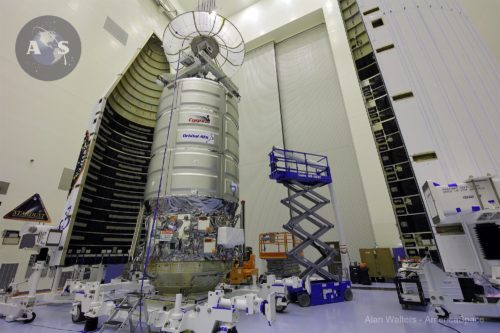
With a highly refined form of rocket-grade kerosene (known as “RP-1”) having already been loaded aboard the Atlas V, the process of pumping liquid oxygen will occur relatively late in Tuesday’s countdown. This allows for the boiled-off cryogens to be continuously replenished until close to T-0. A final “Go/No-Go” poll of all stations, led by the ULA Launch Conductor, will allow teams to press into the Terminal Count and at T-4 minutes the clock will be released from its final, pre-planned hold. During this period, the Atlas V’s propellant tanks will be pressurized and the Flight Termination System (FTS)—tasked with destroying the vehicle in the event of a major contingency during ascent—will be placed onto internal power and armed.
The RD-180 engine will ignite at T-2.7 seconds, ramping up to 860,000 pounds (390,000 kg) of thrust, before leaving the pad at T+1.1 seconds. Climbing vertically for the first portion of ascent, the Atlas V will undertake a pitch, roll and yaw program maneuver, commanded by Centaur avionics, to establish it onto a flight azimuth of 44.4 degrees. The RD-180 will burn for four minutes, then shut down and be jettisoned, allowing the RL-10C engine of the Centaur to take up the baton. With a total propulsive yield of 22,900 pounds (10,390 kg), the Centaur will execute two “burns”, the first running for a little under four minutes, followed by a half-hour “coast phase”, ahead of a second burn, lasting just 11 seconds. This second burn will serve collision-avoidance and Centaur end-of-mission disposal purposes.
During the first Centaur burn, the XEPF will be discarded, exposing the OA-7 Cygnus spacecraft to the near-vacuum conditions of low-Earth orbit for the first time. And during the coast phase, at 21 minutes after launch, Cygnus will separate from the Centaur and enter autonomous flight. At the point of separation, the spacecraft’s orbit will be approximately circular at 142.9 miles (230 km), inclined 51.6 degrees to the equator. This will establish the proper conditions for rendezvous and berthing at the ISS on Saturday, 22 April. This allows the piloted Soyuz MS-04 spacecraft—scheduled for launch and a same-day docking on Thursday, 20 April—to arrive at the station, ahead of Cygnus turning up.
Expedition 51 Commander Peggy Whitson and Flight Engineer Thomas Pesquet will capture Cygnus via the 57.7-foot-long (17.6-meter) Canadarm2 and berth it at the Earth-facing (or “nadir”) port of the Unity node. Capture of the cargo ship is expected around 6 a.m. EDT Saturday, following by the physical berthing at Unity’s nadir Common Berthing Mechanism (CBM) approximately 90 minutes later. Pesquet will lead the capture and berthing operation, with Whitson backing him up. Meanwhile, newly-arrived NASA astronaut Jack Fischer will observe and standby to back up his two crewmates, if necessary. Current plans call for OA-7 to remain attached to the station for more than three months, with a targeted departure in July. This may allow OA-7 to exceed the 91-day record duration spent in space by a commercial cargo vehicle, overtaking last year’s OA-6 Cygnus.
Be sure to “LIKE” AmericaSpace on Facebook and follow us on Instagram & Twitter!
Missions » ISS » Missions » ISS » COTS » CYGNUS »



